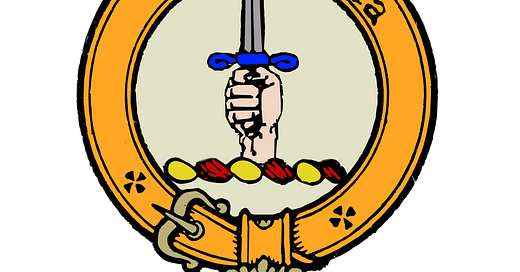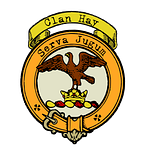Welcome back to "A Clan A Day Podcast," brought to you by bagtownclans.com. I’m your host, Colin MacDonald. Today, we’ll explore the fascinating history of Clan MacIntyre—known as the "sons of the carpenter." This Highland clan is rooted in the mystical stories of ancient Scotland, and today we’ll uncover their tale from a shipwright's cunning to the foresters of Glen Noe.
The origin of the name MacIntyre comes from the Gaelic Mac an t-Saoir, which translates to "son of the carpenter." A traditional account traces the roots of the name back to the 12th century, during the rise of Somerled, the great warrior king who sought control of the Western Isles. Somerled’s ambitions eventually brought him into conflict with Olav the Red, the Norse King of Man and the Isles. When diplomacy faltered, Somerled’s nephew, a wily character named Macarill or Maurice, devised a scheme to win Olav’s favor.
According to legend, Macarill secretly sabotaged the hull of Olav’s galley by boring holes in it, filling them with tallow plugs. As the ship set out to sea, heavy waves washed away the tallow, and the vessel began to sink. In the moment of crisis, Macarill offered to save Olav’s life in exchange for a promise—the hand of Olav’s daughter, Ragnhild, in marriage to Somerled. With Olav’s consent, Macarill plugged the leaks, securing both the king's safety and the alliance. From that day forward, Macarill was known as the "wright," or carpenter, and his descendants adopted the name MacIntyre.
Over time, the MacIntyres left the Hebrides and made their way to the Scottish mainland, settling in Glen Noe, on the eastern side of Loch Etive. According to local lore, the MacIntyres followed a white cow, guided by a prophecy that they should settle wherever the cow lay down to rest. This led them to Glen Noe, where they established their ancestral home. By the end of the 13th century, the MacIntyres had become hereditary foresters to the Lord of Lorn, a role they maintained through various shifts in power, including the rise of the Stewarts and the Campbells.
The early records of the MacIntyre chiefs have unfortunately been lost to history, but we do know that the first chief of record was Duncan MacIntyre, who died in 1695 and was laid to rest in Ardchattan Priory. His marriage to a Campbell of Barcaldine connected the MacIntyres to the illustrious lineage of Robert the Bruce.
Clan MacIntyre's fortunes fluctuated with the tides of Scottish history. During the Wars of the Three Kingdoms, the MacIntyres, like many Highland clans, faced difficult choices. Although they were connected to the Campbells through feudal obligations, their kinship ties to the MacDonalds proved stronger. When Montrose’s royalist forces marched through the Highlands, sparing few in their path, Glen Noe was left untouched due to the MacIntyres’ ancestral ties to Somerled. Many MacIntyres joined the royalist army, while their chief fought with the Campbells at Inverlochy, where the Campbells were routed.
The Jacobite rising of 1745 presented another moment of crisis for Clan MacIntyre. James MacIntyre, the third chief, was born in 1727 and studied law, sponsored by the powerful Campbell Earl of Breadalbane. While his loyalty to the Campbells kept him from joining the Jacobite cause, many of his clansmen secretly supported the Stuart cause, slipping away to fight at the Battle of Falkirk in 1746. The MacIntyre piper marched alongside them, and 10 MacIntyres were killed or wounded at the Battle of Culloden. Despite these sacrifices, the clan did not serve as an independent regiment during the Jacobite uprisings.
In the years that followed, the MacIntyres faced increasing economic pressures. The feudal dues they once paid symbolically, with gifts such as a white calf or a snowball, were converted into monetary rent. By the early 18th century, the Campbells had raised the rent to unsustainable levels. Donald, the fourth recorded chief, was unable to pay and emigrated to America in 1783, leaving his brother Duncan to manage the estate. Duncan held on until 1806, but eventually, he too was forced to leave Glen Noe. The clan’s ancestral lands were lost, though the family maintained their heritage abroad.
Despite these hardships, the MacIntyres continued to honor their Scottish roots. In 1955, Alasdair MacIntyre of Camus-na-h-Erie recorded arms in the Lyon Court, claiming cadet status from the chiefly house. However, it wasn’t until 1991 that the chiefship was officially restored when James Wallace MacIntyre of Glenoe matriculated the correct arms. The current chief, Donald Russell MacIntyre, holds the title of 10th recorded chief of Glenoe, though he prefers a private life. The chieftain of the clan, Ian Malcolm MacIntyre, continues to represent the clan’s interests.
Notable figures in MacIntyre history include Duncan Ban MacIntyre, one of Scotland’s most celebrated Gaelic poets. Born in 1724, Duncan Ban composed works that reflected the landscape and culture of the Highlands. His most famous poem, The Praise of Ben Dorain, is considered one of the finest pieces of Gaelic literature. His legacy, along with that of the MacIntyres, is commemorated by a monument near Loch Awe, erected in 1859.
Today, Clan MacIntyre remains a proud symbol of perseverance, having weathered centuries of hardship and displacement. From their origins as carpenters in the service of Somerled to their role as hereditary foresters in Glen Noe, the MacIntyres have carved out a unique place in Scotland’s storied past.
Thanks for joining us on this journey through the history of Clan MacIntyre. Be sure to tune in tomorrow for another episode of "A Clan A Day Podcast." I’m Colin MacDonald, and as always, Go n-éirí an bóthar leat.













Share this post